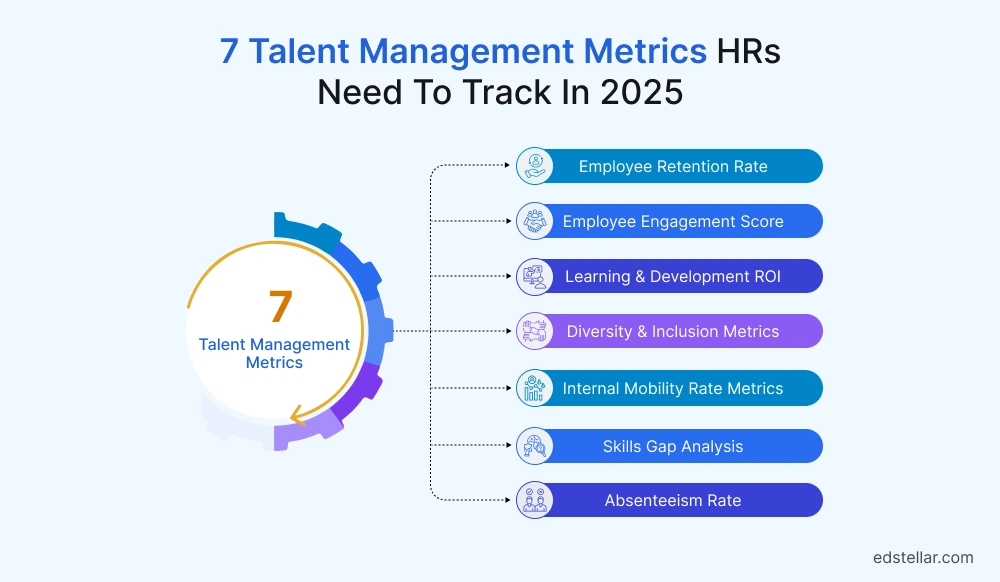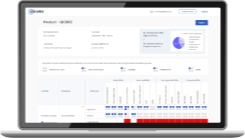
As businesses face economic uncertainty, rapid technological change, and a transforming workforce, simply hiring talent isn’t enough. You need to track and measure the impact of that talent in real time.
McKinsey’s research shows that companies that prioritize talent see higher shareholder returns. But here’s the catch: How do you measure that talent effectively? How do you know if your talent management strategy is working or costing you? The answer lies in talent management metrics.
Without the right talent management metrics, companies are blind to their biggest challenges, whether that’s engagement gaps, high turnover, or skills shortages. Tracking the right metrics enables HR leaders to take control and make data-driven decisions. These aren’t just numbers; they tell a story that can help you optimize your workforce for the future.
In this blog, we’ll dive into the most critical talent management metrics that every HR professional should be tracking in 2025.
7 Talent Management Metrics HRs Need To Track In 2025

1. Employee Retention Rate
Employee turnover is a silent drain on both resources and productivity. Gallup estimates that replacing a leader can cost up to 200% of their salary, while replacing frontline employees can cost as much as 40%.
That's a hefty price tag for something that can often be prevented. In fact, 42% of employee turnover is avoidable, typically due to issues like poor management, lack of employee recognition, and stagnant career growth opportunities.
There's some good news, though. According to Payscale, in 2024, turnover dropped to 18%, down from 26% in 2023. But that doesn't mean the problem is solved. Many organizations continue to struggle with voluntary exits, particularly when employees feel undervalued or perceive no clear path to advancement.
How HR CanYou Leverage This Data:
Formula:

Tracking talent management metrics, such as the Employee Retention Rate, is essential for proactively addressing employee disengagement.
By analysing turnover patterns, HR leaders can take targeted actions to improve employee retention
A strategic focus on retention doesn't just prevent exits, it helps organizations build a loyal, engaged workforce. Tracking retention metrics enables HR to implement initiatives that foster long-term employee satisfaction and career growth, which in turn enhances overall organizational performance.
2. Employee Engagement Score
Gallup's State of the Global Workplace: 2025 reports that global employee engagement saw a troubling decline, falling from 23% to 21%. This decrease cost the world economy an estimated US$438 billion in lost productivity.
What's behind this decline? The primary culprit is manager engagement, which has dropped from 30% to 27% in recent years. Since the pandemic, managers have been struggling to balance new executive demands with evolving employee expectations. The toll this is taking is not just on managers, but also on the teams they lead. 70% of team engagement is influenced directly by the manager, and when manager engagement falters, so does the team's.
The impact on business performance is significant: if left unchecked, this could affect GDP growth, business stability, and long-term success. As Elke H., an Administrative Clerk in Germany, shared, "My supervisor was by far the deciding factor that made me think about whether I really wanted to continue with this." This illustrates how crucial the manager's role is in shaping an employee's experience and overall engagement.
What Can HR Do with This Data?
Using employee engagement metric, HR can identify early signs of disengagement, particularly in leadership teams. If manager engagement is low, it often signals broader organizational issues that need addressing. HR leaders should prioritise leadership training, ensuring that managers are well-equipped to address employee needs and maintain high engagement within their teams.
Formula:

Engaged employees are more likely to thrive in their roles, which directly impacts productivity, retention, and job satisfaction. The engaged workforce is also less likely to experience negative emotions like stress and burnout, which are closely linked to manager engagement. By tracking engagement and responding proactively, HR leaders can ensure their organizations stay healthy, productive, and prepared for the challenges ahead.
3. Learning & Development ROI
If employees feel stagnant in their roles, they often seek opportunities elsewhere. Career development isn't a luxury; it's a necessity for employee retention. Without investment in learning and growth, organizations risk losing top talent to competitors offering better career advancement opportunities. Employee anxiety caused by a lack of growth leads to lower loyalty, engagement, and innovation.
Despite this LinkedIn workplace learning report, only 36% of organizations are "career development champions" with programs that drive business results. Another 31% have limited programs, and 33% are either just starting or have no initiatives at all. The failure to prioritize L&D leaves businesses exposed to the risk of losing talent that could be developed and retained through proper training and career progression opportunities.
When evaluating learning and development ROI, it’s important to track how these talent management metrics correlate to productivity and retention.
Where:
- Business Impact includes outcomes like increased productivity, improved sales, or higher employee engagement.
- Total Cost of Learning Programs includes expenses related to training delivery, materials, employee time spent in training, etc.
Tracking Learning & Development ROI allows HR leaders to quantify the impact of training on overall business success. For HR professionals, it's crucial to move beyond general L&D practices and begin measuring results.
Consider these insights:
- 91% of L&D professionals agree that continuous learning is more critical than ever for career success.
- 88% of organizations say learning opportunities are their top retention strategy.
These statistics highlight that learning programs are business imperatives for improving employee engagement, retention, and overall organizational health. However, HR leaders must measure how effectively their learning initiatives translate to tangible business outcomes such as increased productivity, higher retention rates, and reduced turnover costs.
4. Diversity & Inclusion Metrics
In recent years, DEI initiatives have faced considerable backlash from lawsuits to political attacks. The term “DEI” has increasingly become a scapegoat for broader societal issues, and terms like “DEI hire” are often used to discredit efforts toward gender and racial equity. This polarization has had a clear impact on how companies approach their diversity initiatives.
According to The State of Culture and Inclusion report, 43% of leaders across industries report that anti-DEI activism has affected their efforts, particularly for organizations with global operations, which must navigate local challenges alongside broader societal debates. The polarizing nature of these discussions has led many companies to reconsider the language and approaches used in their DEI programs.
Between 2023 and 2024, there was a 22% decrease in the use of terms like “diversity” and “DEI,” with some companies shifting away from these terms altogether. In contrast, the term “belonging” gained momentum, increasing by 59%. This shift signifies a move from defending DEI terminology to prioritizing the actual work that fosters an inclusive culture where every employee feels valued.
While the political and social challenges surrounding DEI are undeniable, the importance of measuring diversity and inclusion remains critical. Focusing on inclusion creates an environment where employees feel valued, leading to higher satisfaction and lower turnover. Tracking these metrics enables HR leaders to make actionable changes that foster authentic inclusion.
Formula:

By focusing on inclusion metrics, HR leaders can move beyond just representation and ensure that every employee feels valued and has a sense of belonging. Tracking these metrics enables actionable change, helping companies create environments where diverse voices are not only heard but respected.
5. Internal Mobility Rate Metrics
With talent shortages affecting industries across the board, organizations are increasingly turning to internal mobility to fill key roles. Yet, despite this shift, internal candidates are often treated like strangers within their organizations.
According to Aptitude Research, 70% of companies have increased their investment in internal mobility, only 26% personalize communication with internal candidates, and 55% subject them to the same interview process as external hires.
This disjointed approach is contributing to higher turnover rates. Employee burnout is on the rise, with nearly 70% of companies reporting increased burnout, and 78% of companies have lost talent due to a lack of career development opportunities.
As employee retention becomes more critical, organizations must focus on internal mobility.
Formula:

Why Track This Metric?
- Engagement: Employees who see opportunities for growth within the company are more likely to stay.
- Cost Savings: Internal mobility is often more cost-effective than hiring externally.
- Retention: Employees are 75% more likely to stay with the company when given opportunities to grow internally.
Talent management metrics, such as internal mobility rate, help HR leaders assess the effectiveness of internal promotions and career growth opportunities.
6. Skills Gap Analysis
As industries evolve, companies face significant skills gaps that impact growth and performance. According to Gallup's report, 60% of workers who upskilled did so to improve their job performance, while 51% aimed to learn and grow. Despite concerns that upskilling might make employees more marketable to competitors, only 4% say they learn new skills to secure a job elsewhere.
Tracking Skills Gap Analysis helps companies identify where employees need further development. When employees are encouraged to upskill, they are 47% less likely to seek new job opportunities. This demonstrates that learning opportunities not only close skills gaps but also reduce turnover and increase engagement.
Rather than using a standard formula, Skills Gap Analysis involves identifying a set of skills your organization needs and comparing it to the existing proficiency levels of your employees. By evaluating who needs what kind of training, you can create targeted learning programs tailored to close these gaps.
- Identify Key Skills: What specific skills are required for current and future roles in your organization?
- Assess Current Proficiency: Evaluate your employees' current proficiency in these key skills.
- Match the Gaps: Identify which employees need what kind of training to develop the necessary skills.
7. Absenteeism Rate
Employee absenteeism is costing organizations billions of dollars annually. In the U.S. alone, absenteeism costs employers an estimated $225.8 billion, or $1,685 per employee every year. This is not just about missed work hours; absenteeism leads to increased costs for hiring, onboarding, and paying overtime to employees who cover absent colleagues. In fact, 47% of overtime is used to cover shifts when team members are out.
The problem extends beyond finances; absenteeism also severely impacts productivity. Studies reveal that employees steal 4.5 hours per week, which adds up to almost six full workweeks per year. This unaccounted time directly affects organizational performance.
The impact on productivity is staggering. Employee absenteeism results in a 29.5% loss in productivity, directly undermining company performance.
Morale also takes a hit. Disengaged employees have 37% higher absenteeism and 18% lower productivity. Gallup estimates that low employee engagement costs the global economy about $8.9 trillion annually, or 9% of global GDP. This shows the far-reaching impact of absenteeism on both individual performance and overall company success.
By focusing on key talent management metrics, such as absenteeism rates, companies can identify potential issues with engagement and take action.
For a more comprehensive look at workplace absenteeism, including its causes, effects, and strategies for reduction, be sure to check out our detailed blog on Workplace Absenteeism.
To measure absenteeism effectively, the Absenteeism Rate is calculated using the following formula:

This formula provides insight into the percentage of workdays lost due to employee absences. Tracking this metric helps HR leaders identify patterns in absenteeism, address root causes, and implement strategies to reduce its impact.
Conclusion
As businesses face new and evolving challenges, the ability to measure and manage talent effectively is more important than ever. As we've seen, whether it's measuring employee retention, engagement, learning & development ROI, or internal mobility, each metric plays a pivotal role in ensuring that your organization remains agile, productive, and resilient.
Why is this so critical? Because talent is the heart of every organization. Using the right talent management metrics allows HR leaders to make informed decisions that optimize performance and create a more engaged, skilled, and motivated workforce. In turn, this drives higher productivity, better retention rates, and ultimately business growth.
Atn Edstellar, we understand the challenges HR and L&D professionals face when it comes to managing talent. That's why we offer specialized training programs and advanced tools to help you assess and bridge skills gaps effectively. With our Skills Matrix Software, we can help you identify unique skill gaps within your organization and provide personalized training solutions for every employee, empowering them to perform at their best.
Our expert L&D consultancy is designed to support organizations in upskilling their workforce, enhancing employee engagement, and building sustainable, future-ready talent pipelines.
By choosing Edstellar as your trusted training provider, you can ensure that your employees are equipped with the right skills to tackle the challenges ahead, ultimately driving success across the organization.
Remember, tracking talent management metrics isn't just about numbers; it's about strategic action that leads to long-term success. Embrace these metrics, make data-driven decisions, and build a workforce that excels in today's fast-paced world.
Let's create a future-ready workforce together. Reach out to us at Edstellar to get started on your journey towards talent optimization!
Explore High-impact instructor-led training for your teams.
#On-site #Virtual #GroupTraining #Customized

Bridge the Gap Between Learning & Performance
Turn Your Training Programs Into Revenue Drivers.
Schedule a ConsultationEdstellar Training Catalog
Explore 2000+ industry ready instructor-led training programs.

Coaching that Unlocks Potential
Create dynamic leaders and cohesive teams. Learn more now!


Want to evaluate your team’s skill gaps?
Do a quick Skill gap analysis with Edstellar’s Free Skill Matrix tool

Transform Your L&D Strategy Today
Unlock premium resources, tools, and frameworks designed for HR and learning professionals. Our L&D Hub gives you everything needed to elevate your organization's training approach.
Access L&D Hub Resources.svg)
.svg)



.svg)


.svg)
.svg)
.svg)
.svg)

